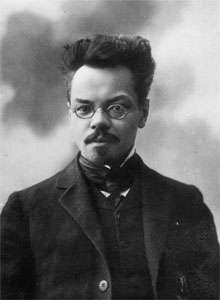Aleksey Remizov
Aleksey Mikhailovich Remizov (Russian: Алексе́й Миха́йлович Ре́мизов; 6 July [O.S. 24 June] 1877 in Moscow – November 26, 1957 in Paris) was a Russian modernist writer whose creative imagination veered to the fantastic and bizarre. Apart from literary works, Remizov was an expert calligrapher who sought to revive this medieval art in Russia.
Aleksey Remizov | |
|---|---|
 | |
| Born | Aleksey Mikhailovich Remizov July 6, 1877 Moscow, Russia |
| Died | November 26, 1957 (aged 80) Paris, France |
| Alma mater | Moscow University |
| Occupation | Writer |
Biography
Remizov was reared in the merchant milieu of Moscow. As a student of the Moscow University, he was involved in the radical politics and spent eight years in prison and Siberian exile. At that time, he developed a keen interest in Russian folklore and married a student of ancient Russian art, who brought him in contact with the Roerichs.
In 1905, he settled in Saint Petersburg and started to imitate medieval folk tales. His self-professed ambition was to catch "the bitterness and absurdity of folklore imagination". Remizov's whimsical stylizations of the saints' lives were ignored at first, partly due to their florid and turgid language, but his more traditional prose works set in the underworld of Russian cities gained him a great deal of publicity.
In his satirical novel The Indefatigable Cymbal (1910) Remizov depicted the eccentricities and superstitions of rural sectarians. Another striking work of this period is The Sacrifice, a Gothic horror story in which "a ghostly double of a father comes to kill his innocent daughter in the mistaken belief that she is a chicken".[1]
By the time of the Russian Revolution, Remizov had concentrated on imitating more or less obscure works of medieval Russian literature. He responded to the revolution by the Lay of the Ruin of the Russian Land, a paraphrase of the 13th-century work bemoaning the Mongol invasion of Russia. In 1921 he moved to Berlin and then in 1923 - to Paris, where he published an account of his attitudes towards the revolution under the title Whirlwind Russia (1927).
During his years in exile, Remizov brought out a number of bizarre works, featuring demons and nightmare creatures. The writer also developed a keen interest in dreams and wrote a few works on the subject that involved prominent figures of Russian literature (Gogol, Dostoyevsky and others). Although he was so prolific many of his works failed to find a publisher (in fact, from 1931 to 1952 there was not a single book published),
Remizov was also the first Russian modernist author to attract the attention of the luminaries of the Parisian literary world, such as James Joyce. His reputation suffered a decline when, following World War II, he announced his interest in returning to the Soviet Union and even obtained a Soviet passport (which he did not have a chance to use). After that, Remizov was abhorred by the émigré litterateurs, the most famous of whom, Vladimir Nabokov, used to say that the only nice thing about Remizov was that he really lived in the world of literature.[2] The years 1952 to 1957 saw a number of Remizov's books published, though only a very limited number of copies were printed.
Books on Remizov
- Friedman, Julia. Beyond Symbolism and Surrealism: Alexei Remizov's Synthetic Art, Northwestern University Press, 2010. ISBN 0-8101-2617-6 (Hardback)
English translations
- The Fifth Pestilence, Together With the History of the Tinkling Cymbal and Sounding Brass, and Ivan Semyonovitch Stratilatov, Wishart, London 1927; also published by Payson & Clarke, Ltd., New York, 1928, and re-published by Hyperion Press.
- The Clock, Chatto and Windus, London, 1924; also published by Alfred A. Knopf, New York, 1924, and re-published by Hyperion Press, 1977.
- On a Field Azure, Lindsay Drummond, London, 1946.
- Esprit, Christ's Godson, Faith in Nikolai, and Jacob Betrayed, from A Russian Cultural Revival, University of Tennessee Press, Knoxville, 1981.
- Selected Prose, Ardis Publishers, Michigan, 1984.
- The Little Devil, from 50 Writers: An Anthology of 20th Century Russian Short Stories, Academic Studies Press, 2011.
References
- Charles Moser. The Cambridge History of Russian Literature. Cambridge University Press, 1992. ISBN 0-521-42567-0. Page 442.
- Andrew Field. The Life and Art of Vladimir Nabokov. New York, 1986. Page 188.
External links
- Works by Aleksey Remizov at LibriVox (public domain audiobooks)

- Works by Aleksey Remizov at Project Gutenberg